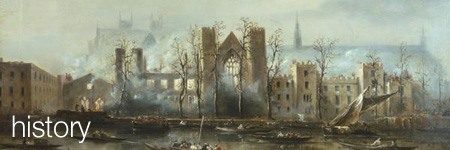
King Street
Westminster (SW1) was renamed after King Charles II. Oliver Cromwell resided there previous to his usurpation. The poet Edmund Spenser lived in King Street for a short time and died there too in the reign of Elizabeth I. (Reference: Jesse's London, vol. I, pp. 157-60)
This was once the principal street of the City of Westminster, and in the time of Henry VIII had gardens or meadowland on the east side reaching down to the river. The Cockpit was at the north end, and the High Gate of Richard II at the southern extremity. In succeeding reigns the carriage-way was in such a ruinous condition that faggots had to be thrown into the ruts to facilitate the passage of the royal carriages when the king went to Parliament. Doubtless this street witnessed the deaths of some of the incautious crowds, when, on October 24, 1597, at the opening of the session, "divers people were smothered and crushed to death, pressing betwixt Whitehall and the College Church, to have seen her Majestie and nobility riding to the said Parliament."
Dudley, the second Lord North, had a house here, about 1646, which was the first brick house in the street. His son, Sir Dudley, was robbed by beggars, and retaken in an alley while he was being stripped of his clothes.
Through this street King Charles I was brought on his way to his trial in Westminster Hall, while people came forth from their stalls and workshops to lament and pray for him. In 1681 there was but one coach running to this parish, and it is thus noticed in a small book of the day: "Mr. Burt's coach comes to the George in King Street, Westminster, from Windsor, in and out every day." (Reference: Walcott's Memorials of Westminster, pp. 69-71)